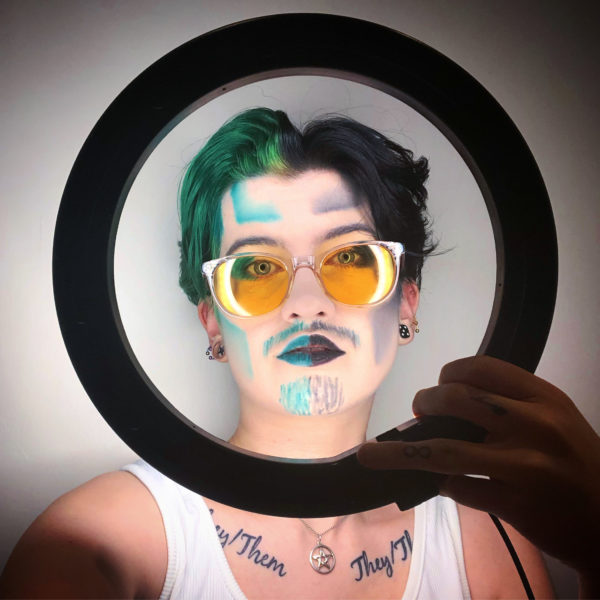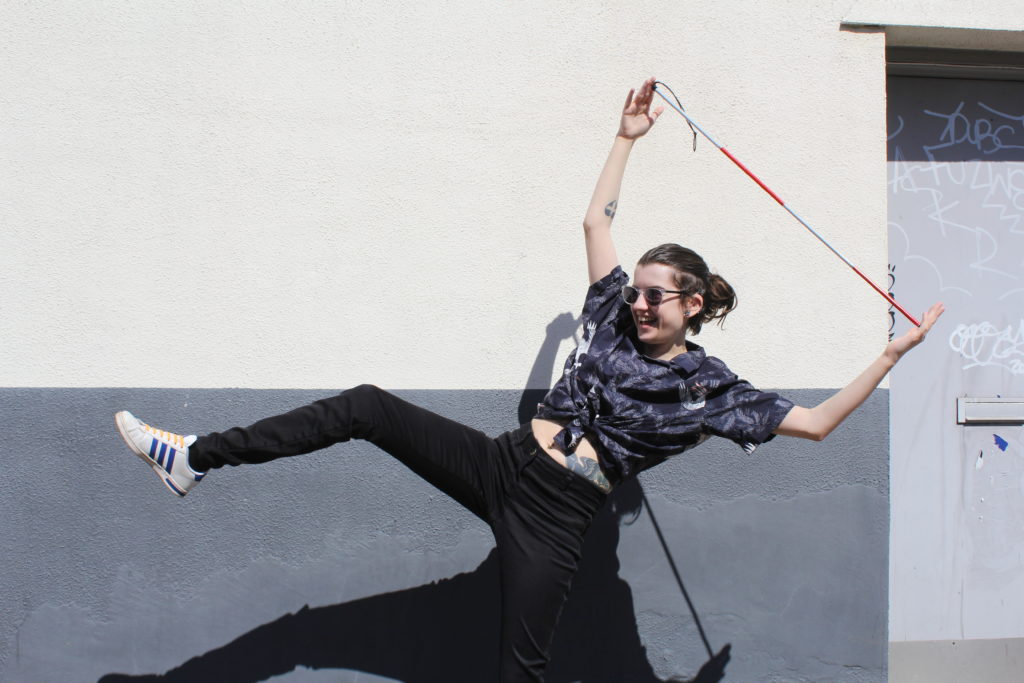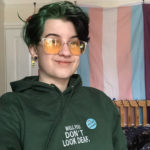My life as a deafblind drag king
Max is a deafblind drag king from Cambridgeshire. They explain how being deafblind affects their performances and how venues can be more accessible to performers like them.
My name is Max, but some people know me as Papa Smear. I am a deafblind drag king based in Cambridgeshire. Drag kings are drag artists that typically play with masculinity (in all meanings of the word) as part of their drag, and anybody can do it regardless of their gender. I have a rare visual impairment called Visual Snow Syndrome, and I am also Deaf. I sit on the milder end of the deafblind spectrum. When the lighting is perfect I can easily be perceived as sighted and hearing. However, perfect lighting seldom exists, least of all at drag shows. Or in front of my mirror apparently.

Making mistakes look deliberate has become part of the fun
Getting into drag usually (for me at least) involves a lot of powders – be it foundation, contour, eyeshadows, glitter etc. Because of my visual impairment, my entire field of vision is covered in a thick TV static, which makes it hard to distinguish between what is the powder, and what is just my eyesight. This very often makes it very difficult to see how much pigment is on the end of my bristles, which has lead to some “interesting” looks.
This has become part of the fun. How can I make the big orange smudge look like it’s meant to be there? My visual impairment adds to this, because what looks nice in my bedroom often looks overly bold under bright lights, or completely disappears when I enter a club. I like to think that I’ve figured out this balance now: I can put on a passable face in about 20 minutes.
The venues I perform in can be inaccessible
Walking into a venue, it’s often very loud, and the spotlights on stage leave some areas far too dark, and others far too bright. I wear hearing aids with voice recognition to help with this, but with the music and dozens of people talking at once, understanding sounds can still be very difficult. My tinted lenses help with the bright lights, but they make it a little harder in the dark spots. I usually bring a small notebook for people to write on if I’m having a particularly hard time, and I carry a red and white symbol cane so people give me space and help me out if I need it.

When I’m on stage, though, it’s just me and the music. I practice as much as I can beforehand so that I know all my words, and all the timings of the song. I can’t always hear the song clearly, so it really helps to practice the song on a really quiet volume so I don’t have to rely on my hearing. I can also ask the hosts to turn the volume up, or turn a speaker towards me to help. Green flags I look for in a venue are hosts that actively want to get involved in making the venue accessible for everyone, and hosts that allow flexibility around the theme or the energy of the piece.
How to make drag open for all
There are so many ways to make drag accessible for artists with sensory loss. Fellow drag performer Sigourney Beaver and I have talked about how hosts can make shows accessible for performers like us. A lot of it is stuff that we as drag artists have to take care of, but there are many ways the hosts can get involved in too.
Inviting a deaf person who uses British Sign Language (BSL) on stage during the introduction to teach the audience how to use BSL applause is a great idea, and for me, makes my performance super accessible. I can’t hear my track if they’re clapping and cheering over it!
I also have great fun including my sight cane and my hearing aids in my performances. Have I used my symbol cane to pole dance? Yes. Do I want to do a rendition of singing in the rain and use my symbol cane as the umbrella? Also yes. Can I actually dance? Not so much, no.
Using smells and textures in my drag
As a genderqueer person, I enjoy playing with gender presentation in my drag, and while being deafblind should not hold me back, I just need to do things differently sometimes. Even though it doesn’t show up in any photos, and only the front row might be able to tell, incorporating scent into my look really makes a difference for me, and puts me in the zone.
Different textures of clothing in my outfit can make it a really tactile experience for me, and I have a goal to start incorporating more sign language into my performances. I’m still learning, but I think a few key signs here and there will help my performance overall, and make it a bit more fun for the crowd when they realise I actually can’t dance at all.
“We are creative, we are talented, and we are a part of the community too.”
My favourite thing about being a deafblind drag king is the sheer amount of opportunity there is to be creative. I can’t always perform the same way as other drag artists, but I have so many things I can do instead.
I can experiment with textures, scents, sign language, and mobility aids which not everyone can, all the while raising awareness of Deafness, visual impairment, and deafblindness.
Being a deafblind drag king means shattering people’s perceptions of deafblindness and letting people know that we are more than our sensory loss. We are creative, we are talented, and we are a part of the community too. And it’s vital that people know this, because we are too often faced with stigma and disbelief.
We are not as rare as you think we are. People are often shocked to learn that not only am I deafblind, but I’m queer too, largely down to the infantilisation of disabled people, but also because we are perceived to be so rare we are non-existent.
We walk among you, and I am proud to do so. Who wouldn’t be?
Want more inspiring stories like Max’s in your inbox?
Sign up to get inspiring stories, news from our campaigns and ways to get involved, all delivered to your inbox.

